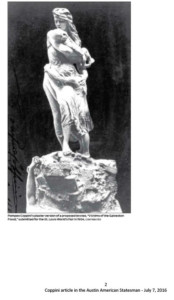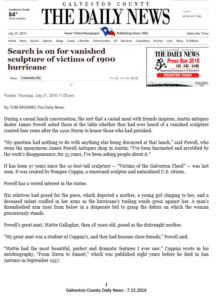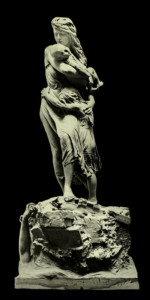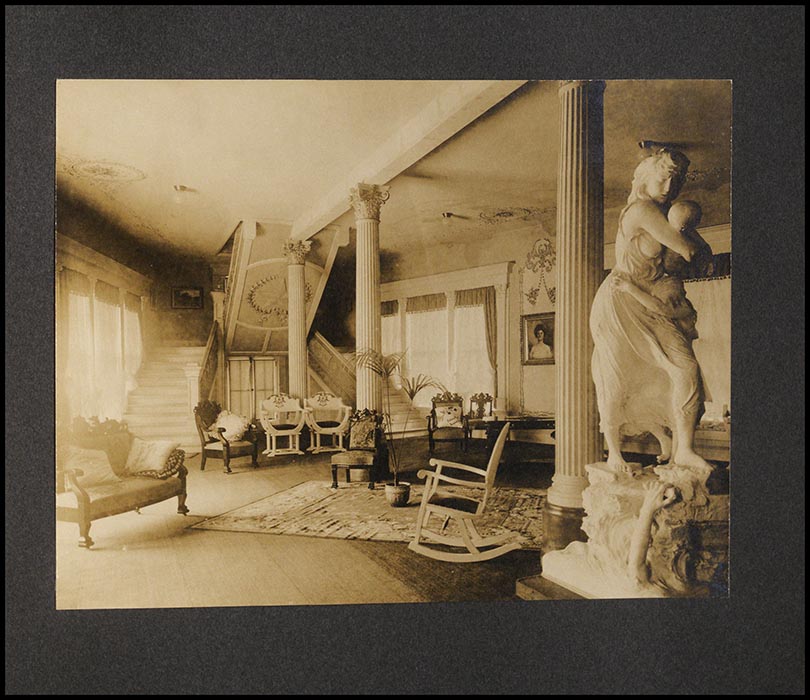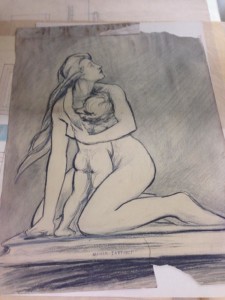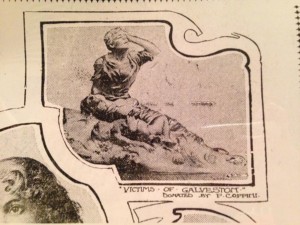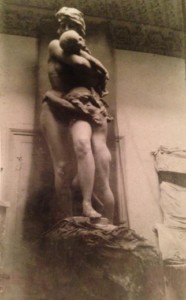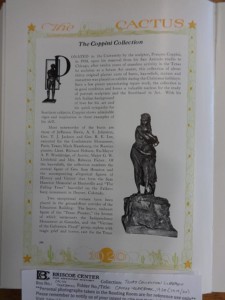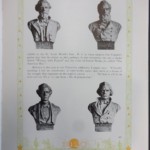Victims Heroic Statue Project History
 The Lost Coppini Statue Project was created in 2016. The Project seeks to re-create the 10-foot tall statue sculpted by Italian sculptor Pompeo Coppini in 1904. This heroic work, entitled “Victims of the Galveston Flood” was created to honor the over 8000 people who died in the catastrophic hurricane that ravaged Galveston, Texas on September 8, 1900. The Victims statue was lost over 100 years ago and has had a troubled history since its creation in Coppini’s San Antonio studio.
The Lost Coppini Statue Project was created in 2016. The Project seeks to re-create the 10-foot tall statue sculpted by Italian sculptor Pompeo Coppini in 1904. This heroic work, entitled “Victims of the Galveston Flood” was created to honor the over 8000 people who died in the catastrophic hurricane that ravaged Galveston, Texas on September 8, 1900. The Victims statue was lost over 100 years ago and has had a troubled history since its creation in Coppini’s San Antonio studio.
The original design presented to Galveston was made of plaster and was rejected by Galveston leaders shortly after the Storm that same year, as being “too painful”. Hence, Coppini was not commissioned to create the statue in bronze. In 1904 the statue was sent to St. Louis World’s Fair to be exhibited in the Fine Arts Pavilion. The statue was lost for two weeks. Inadvertently labeled fruit, it was found in a cold storage warehouse on the fair grounds. Unfortunately, the statue could not be officially entered in to the arts competition at the Fine Arts Pavilion. It ended up being summarily relegated to a parlor in the Texas Building.
The Victims sculpture was later donated to the University of Texas in Austin in 1914. It is tragic that this sculpture, along with 23 other works donated by Coppini to UT, all vanished from the UT campus in the early 1920’s. There is no record of the loss. A UT search in 2016 did not recover any of Coppini’s work. Only three photographs of the finished heroic statue survived.
Coppini’s Victims heroic statue is one of the most powerful and moving works of his career. The Lost Coppini Statue Project hopes to see the magnificent Victims statue cast in bronze, full scale, as Coppini originally intended and thence installed in Galveston.
The story of the mysterious loss of Coppini’s Victims heroic from the University of Texas Austin campus was originally brought to John Bernardoni on April 27, 2016 by the nephew of the woman that posed for the statue along with his two nieces who also posed. During a luncheon having nothing to do with this subject, James Powell asked John, “Do you know anything about Pompeo Coppini’s statue, “The Victims of the Galveston Flood” which disappeared from the University of Texas campus?” John was greatly moved by this story, as his Italian family were part of the Galveston community for over 80 years. John also lost his great grandfather in the Storm of 1900.
After seeing photographs of this significant sculpture, John was so impressed and inspired he immediately began major efforts to locate the original Victims statue. He was determined to unravel this mystery. This search included the canvassing of 70 organizations, over 4000 emails and phone calls, an intense research effort with Ralph Elder, a 25 year veteran archivist with the Briscoe Center lasting months and an exhaustive UT building search at the Austin campus. Sadly, the Victims statue was not found. A second effort was launched immediately to identify a possible benefactor to finance the re-creation of the statue.
The re-creation of a full size, 10-foot bronze matching the existing photograph of Coppini’s statue is the ultimate goal of the project.
Coppini Statuary Timeline – Donated Items To UT 1914
September 1900
Storm of 1900
October 1900
1900
On October 17, 1900, William Randolph Hearst launched a New York Times promotion to raise money for victims of the 1900 Storm at the Galveston Orphan’s Bazaar which took place at the Waldorf Astoria. Coppini came to the attention of NY and Texas socialites with his winning entry of an early maquette design to commemorate the victims”.
Galveston leaders turn to Pompeo Coppini to design a monument to commemorate those who died. He brings them the design you see in the photo. The leaders say it is “too painful” and they decided not to award the commission.
April 1904
1904
Coppini decides to go ahead and create a 10 foot tall plaster cast for exhibition at the St. Louis World’s Fair in 1904. Prior to shipping, Coppini puts out a notice to the world that the heroic will be on display at his studio in San Antonio for three days. Some of the survivors come as well as families of those who drowned. The mood is extremely sad, people crying and so on. When it is over, Coppini goes out to his porch and cries like a grandmother.
At the St. Louis World’s Fair (also called the Louisiana Purchase World’s Fair), he is to be given premium space in the Fine Arts Building. The San Antonio Fire Engine crew comes to his studio to move the gigantic cast to the train station. An arm breaks and Coppini has to repair it post haste. In St. Louis, the shipping create is mistaken for fruit and stored in a food warehouse.” The St. Louis managers therefore missed the deadline to get it in place in the Fine Arts Bldg. It ends up being relegated to the Texas Building, instead. It returns, ultimately, to Coppini’s studio for the next 10 years.
December 1904
1904-1914
The Victims heroic is in Coppini’s studio in San Antonio.
April 1914
1914
January 1918
1918
Students from the Longhorn Magazine stumble upon numerous large crates in the basement of Old Main. Upon learning that they contain artworks donated by Coppini, they demand to have them exhibited. It appears that the statuary and the Victims heroic were stored in the Chemistry Building, in 1918, and later, on the third floor of Old Main and then in the basement of Old Main, from records on hand. It is unknown why the statuary were not exhibited from 1914-1919.
December 1919
1919
We believe most of the donated items are exhibited in the Education Building (now Sutton).
January 1920
1920
January 1928
1928-1942
March 4, 1928 American Statesman article that says someone found “10 busts” in the 3rd floor of Old Main. It doesn’t say who found them nor does it name what is found. It also says nothing about the other 14 pieces (statues, heroic busts).
We can find no other mention of the 24 item statuary to the present time.
Coppini unsuccessfully queried UT from the early 1920’s through the early 1950’s
January 1933
1933
The Littlefield Fountain, unveiled in 1933, is a monument by Italian-born sculptor Pompeo Coppini, located at The University of Texas at Austin. UT and Coppini came to loggerheads over design disputes with UT architect, Paul Cret and others. Between UT’s loss of Coppini’s 24 piece statuary and the fountain that was redesigned without Coppini’s approval, a rift was in full bloom for the next 20 years.
Major George W. Littlefield financed the memorial for University of Texas students and alumni who died in World War I.
January 1943
1943
January 1948
1948
Coppini’s requests for an answer as to the whereabouts of the Victims heroic reaches a crescendo in advance of his autobiography, From Dawn To Sunset, being published in 1949. We can find no evidence of a document where UT gives him an answer.
January 1955
1955
Carl Eckhardt, UT’s long-time Director of the Physical Plant, makes a typewritten note to himself regarding UT’s inability to “properly preserve” the Coppini gift collection over time. Eckhardt and Coppini had become close friends leading up to the Daughters’ of the American Revolution funding Coppini’s George Washington statue situated just south of the UT Tower.
September 1957
1957
Coppini dies.
April 2016
April, 2016
John writes to Peter Mears at the HRC and Blanton Museum. The list of those who might have information grows to Baylor, Galveston, and San Antonio and 70 individuals, institutions, organizations and media.
May 2016
May, 2016
May, 2016 to Present
Over 80 individuals and/or institutions have been a part of the conversation to try to shed light on solving the mystery of 24 missing Coppini works of art. John continues to have contact with leads. See previous list of organizations and individuals contacted to date. The Austin American Statesman, The Daily Texan and the Austin Chronicle have also been initially contacted. Ralph Elder, a former 25 year veteran archivist at the Briscoe Center, and John continue the search. I personally believe some or all of these items are at the Pickle Research Center (formerly Balcones Research Center), which was taken over, by UT, after WWII from the army. If the Victims heroic is lost, in time, it is our hope to find a way to have it fully realized, in bronze, as was originally planned.
Articles
KUT Radio Broadcast – July 13, 2016

Victims Photos
